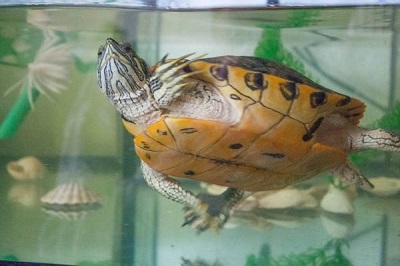Common turtle diseases
Although the pets par excellence are dogs and cats, more and more other animals that live in homes are appreciated as companion animals. This is the case of the turtle. If you are thinking of hosting one of them (or several) in your home, the ideal thing is that you know her well and that implies knowing what most frequent pathologies she can develop. Let’s see what are the most common turtle diseases.

Getting to know the turtles a little more
Turtles or chelonians are reptiles whose main characteristic is that they have a shell that protects their vital organs.
Despite the fact that this shell provides a defense that other animals do not have, they are not exempt from suffering from multiple diseases.
If you consider having a turtle at home, you should know that there are currently some 360 species registered around the world. However, not all species of turtles are suitable for life in homes.
The most common among pets are alligator sliders, red-eared sliders, and land sliders. All of them can reach a considerable size, in addition to being quite long-lived.
Common turtle diseases
The most common turtle diseases usually appear due to improper handling of the turtles or poor nutrition by their owners. This is usually caused by a lack of knowledge of their needs, as well as problems derived from their anatomy.
Among the most frequent pathologies that these animals can suffer are the following.
Carapace fractures
They can be caused by falls or by an animal attack, such as a dog bite.
Fractures can be more or less serious, but in the most damaging ones, the internal organs will be affected, worsening the animal’s prognosis.
Metabolic bone disease
This disease usually results as a direct consequence of an unbalanced diet, which does not cover the turtle’s needs for vitamin D3 and/or calcium. It may also be because that diet offers an excess of phosphorus.
The most obvious symptoms occur in the shell, producing deformities and lack of consistency.
In addition, the shell will suffer continual infections, as microorganisms take advantage of trauma and breaks to penetrate it and cause more problems.
Middle ear abscesses
Normally, they occur when their defenses drop, since this favors infections.
This drop may be due to poor nutrition, the fact that the animal is in an environment with a lower than adequate temperature or that its water is contaminated.
Abscesses in reptiles are different from those in people, since the pus in them is very hard and difficult to drain. Therefore, they will always need veterinary attention.
Drop
It consists of the accumulation of uric acid in the joints. It is common to happen due to kidney failure, a diet rich in protein or certain medications.
Malnutrition and dehydration
Although they are more common in land tortoises than in aquatic ones, you have to be very careful with these problems in all cases.
The excretion of pasty or liquid feces indicates that the animal suffers from malnutrition or some intestinal infection.
For its part, that the reptile has its eyes retracted indicates dehydration.
infectious stomatitis
Another of the most common turtle diseases is infectious stomatitis.
This is usually a secondary disease caused by bacteria, which take advantage of a defense deficit in the animal caused by inadequate feeding or mishandling.
respiratory processes
This is one of the most common turtle diseases.
Due to the anatomy of the respiratory system of these animals, its secretions are removed with too much difficulty, so it can be colonized by viruses, bacteria or pathogenic fungi.
Within the respiratory processes, one of the main problems is rhinitis in turtles.
ectoparasites
They are external parasites, being the most common in turtles, fly larvae and ticks.
It should also be noted that they are more frequent in land turtles than in aquatic ones.
endoparasites
They would be the internal parasites. Some may be microscopic, such as coccidia belonging to the genus Eimeria.
However, there are also macroscopic ones, such as the worms of the genera Oxyuris or Angusticaecum.
Hypovitaminosis A
This is another of the most common turtle diseases.
The pathology causes a deterioration of the epithelia due to a shortage of vitamin A, due to a deficient diet. This diet is usually made up of low-quality prepared food or based exclusively on meat products.
One of the most obvious symptoms is usually closed and swollen eyes. Other signs are nasal discharge, skin infections, and weight loss.
It is important to provide the animal with a diet rich in vegetables to avoid it.
